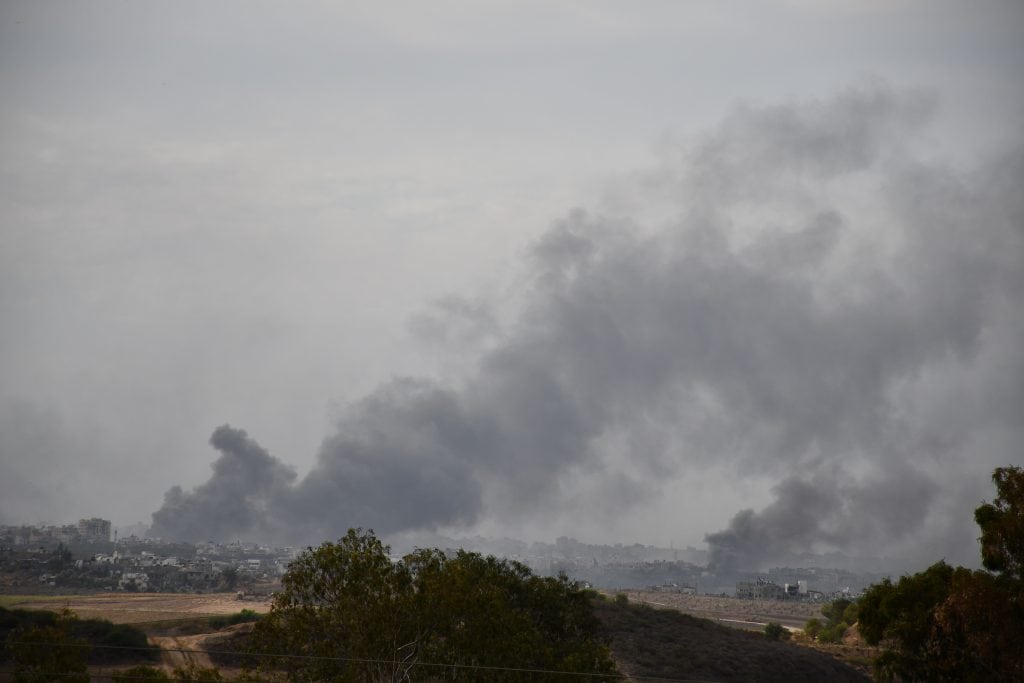
Smoke billowed from the northern Gaza strip as fighting persisted Wednesday ahead of a ceasefire deal expected on November 23. The dark black smoke which came out of a neighborhood in Gaza City was bookended by additional evidence of clashes, from the sound of artillery fire to flares in the sky, while a helicopter kept watch overhead. Hamas continued firing rockets into southern Israel, as confirmed by the two Iron Dome interceptors that I saw streak over Sderot on Wednesday afternoon. Both intercepted targets overhead.
Sirens also sounded in Israel’s southern city of Eilat on Wednesday due to a cruise missile threat, the second time the Israel Air Force used aircraft to down cruise missiles after F-35s downed one in early November. The Iran-backed Houthis have threatened Eilat with cruise missiles, drones and ballistic missiles since October 7. This week, the group hijacked a ship and vowed to continue hijacking ships in the Red Sea that are linked to Israel.
Sderot, like other communities near Gaza, is near-deserted. It was evacuated during the early days of the war. Nevertheless, more civilian traffic was visible Wednesday, as people shopped at a local supermarket. This week, the two regional councils composed of rural communities near Sderot both rejected claims that people might soon return to the periphery of Gaza. They said any return would be conducted gradually and each community would return at its own pace. Some communities were badly damaged during Hamas’ October 7 attack in Israel that resulted in more than 1,200 civilians being killed and another 240 taken as hostages.
The ceasefire deal between Israel and Hamas is expected to yield the release of some hostages over the next several days. The deal could then be extended. It remains to be seen if the deal will work as expected.
Israel’s Defense Minister Yoav Gallant held a call with his French counterpart, Minister of the Armed Forces Sebastien Lecornu, Gallant’s office said Wednesday. “Minister Gallant briefed Minister Lecornu on the framework reached for the release of Israeli hostages kidnapped by the Hamas terrorist organization to Gaza. Minister Gallant emphasized that the return of all the hostages to their homes, is both a national priority and a stated goal of the war – a goal that may only be achieved via continued military pressure against Hamas,” Gallant’s office said. Echoing demands made by Israel during ceasefire negotiations, Gallant called for the international community and NGOs like the Red Cross to be responsible and visit the hostages in Gaza, something that has not yet happened since they were taken on October 7.
Gallant and his French counterpart also discussed tensions in the north with Hezbollah. “Minister Gallant noted that the State of Israel will not tolerate threats against its citizens and will take the measures required to defend our northern communities,” his office said. Gallant spoke after Israel’s Iron Dome was activated overnight to target a drone that flew from Lebanon into Israel. The IDF also used fighter jets to strike terrorist infrastructure in Lebanon: “IDF aircraft together with artillery struck a Hezbollah terrorist cell that fired from Lebanese territory toward the area near Hanita in northern Israel,” the IDF said.
The IDF shared additional evidence of terrorist tunnels underneath Shifa hospital, Gaza’s largest, which the IDF secured last week. In new footage released by the IDF, hostages are seen being taken to the hospital by Hamas on October 7. On Wednesday, the IDF also shared images of a terror tunnel route it said “extends from under the hospital building” and was “dozens of meters of a tunnel system which also passes under the Qatari Building in the hospital complex, as well as rooms where Hamas terrorists can operate and stay for extended periods.” IDF special units such as the Oketz Unit that works with canines and engineers were involved in exposing the tunnel. Air conditioned rooms were found in the tunnel, and one tunnel shaft extended to a nearby civilian home.
In another area of Gaza, the IDF said the Givati Brigade located more tunnels. The unit also found models of an IDF vehicle and the Gaza security fence, apparently used by Hamas for training. The IDF said Wednesday that “soldiers have exposed and destroyed approximately 400 terror tunnel shafts” since the ground operation began on October 27. “IDF troops conducted targeted raids in the area of Beit Hanoun. During the operation, the troops located numerous weapons, AK-47 rifles,” it said.







